Hiring Begins to Shift to Private-Sector where Hiring Jumped, while Hiring by Governments Slumped.
By Wolf Richter for WOLF STREET.
The circular relationship between quits, job openings, hires, and fires – the data released today – shows the churn in the labor market, in addition to growth aspects. And now it also begins to show a shift from government hiring to private-sector hiring.
Labor-market churn went wild in 2021 and 2022, when workers quit in huge numbers to jump to better jobs, thereby leaving behind large numbers of slots that had to be filled, and then a large number of hires to fill those left-behind job openings. This churn reshuffled the entire labor market, and many workers ended up with jobs that paid more and matched their skills better than before.
But starting in mid-2022, Corporate America, especially Big Tech, cracked down on churn and soaring wages with huge layoff announcements to scare the bejesus out of their employees and make them thankful they even still had a job. And worried workers quit quitting. So left-behind slots plunged, and job openings plunged, and hires to fill those job openings also plunged.
And the low-point of this new calm in the labor market was roughly in August to November, and since then quits, job openings, and hires have risen. But even at the point of peak-calm, job openings remained historically high, and layoffs and discharges remained historically low.
Quits – the number of people who voluntarily quit their jobs – declined by 61,000 in February from January, after a big jump in January, to 3.19 million, seasonally adjusted (blue).
The three-month average, which irons out the month-to-month squiggles and revisions, jumped by 54,000 in February to 3.18 million quits, the highest since September (red).
Quits remain below the levels of the tight job market in 2018 and 2019, attesting to a workforce that is still smarting from having gotten hit over the head with layoff announcements.
In terms of the trend, this is the first multi-month upturn in the three-month average since the peak in April 2022.
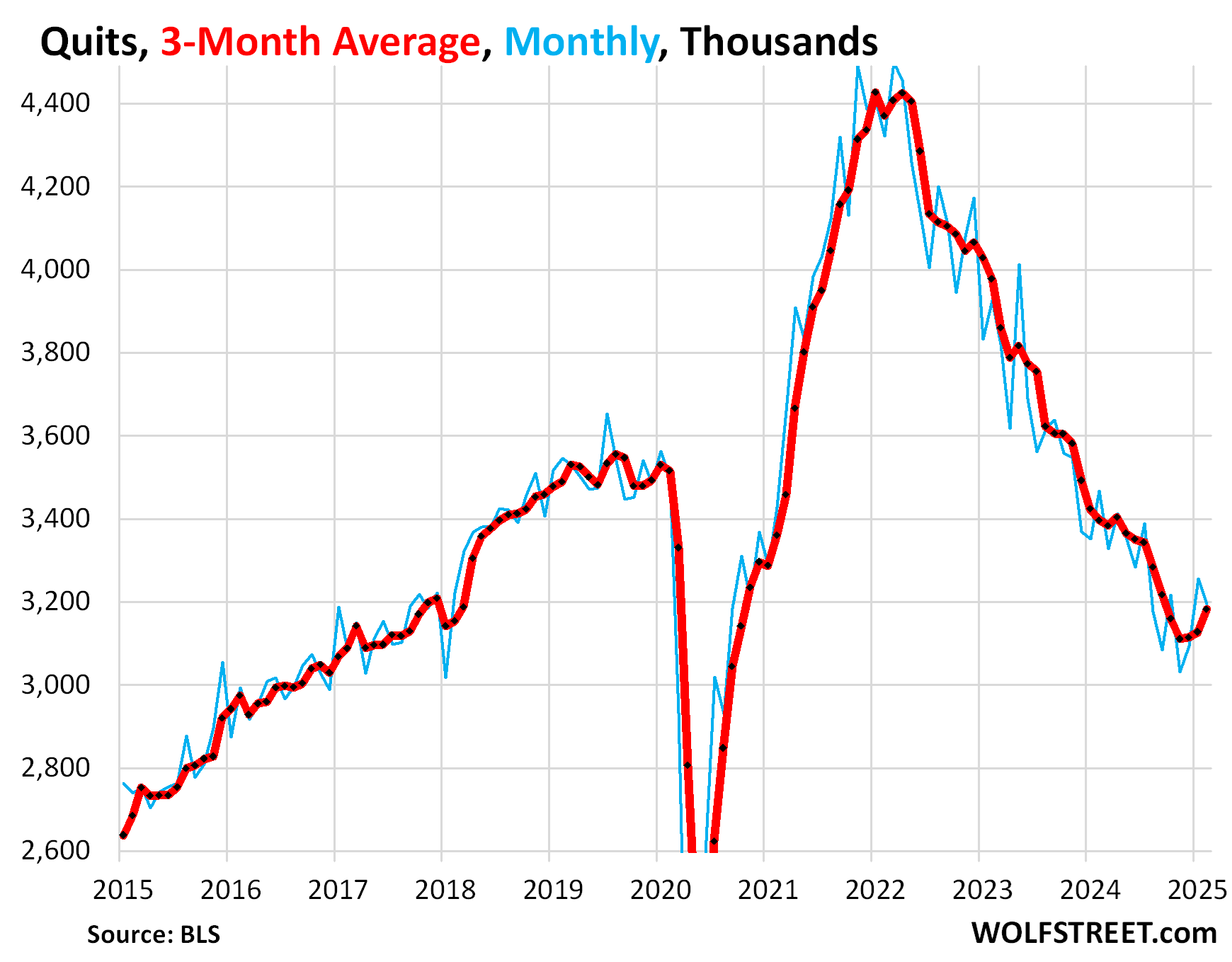
Job openings declined by 195,000 from upwardly revised jump in January (+254,000), seasonally adjusted, to 7.57 million openings. The low point was in September with 7.10 million openings (blue in the chart below).
The 7.57 million job openings are mostly to fill jobs left behind by quits, layoffs & discharges, and other discharges, such as retirements. The separately reported growth in nonfarm payrolls, coming this Friday, reflects the change in total nonfarm payrolls.
This data from the Job Openings and Labor Turnover Survey (JOLTS) by the Bureau of Labor Statistics today is based on surveys of about 21,000 work locations, and not on online job postings.
The three-month average job openings dipped in February to 7.61 million, after rising four months in a row from the low point in September (red).
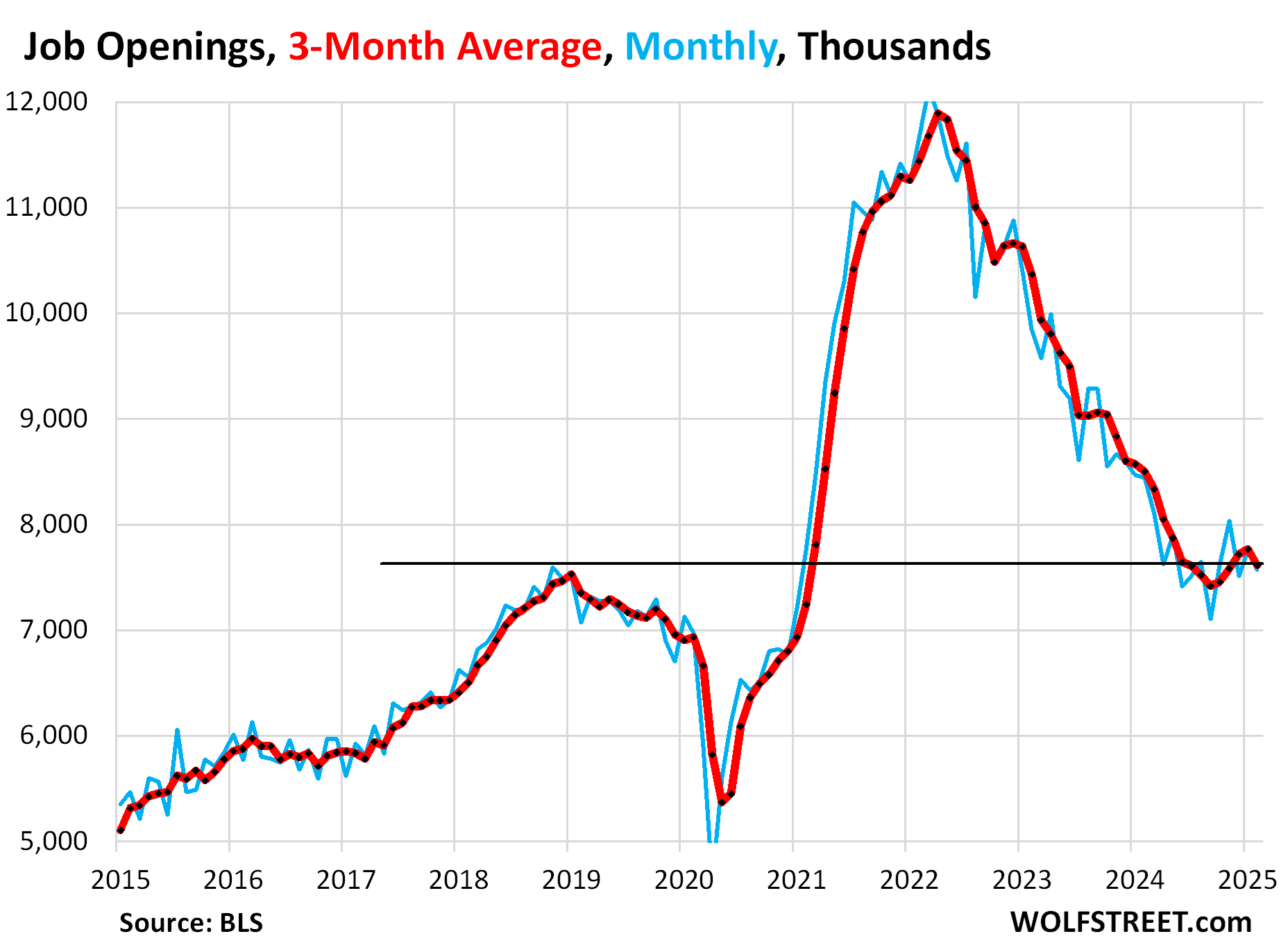
The figure Powell cites a lot: The number of job openings per unemployed person dipped to 1.07 job openings for each person who was unemployed and looking for a job during the reference period (7.57 million openings for 7.05 million unemployed).
The low point was in September, when the Fed got spooked by the direction of the trend, but just then the trend changed.
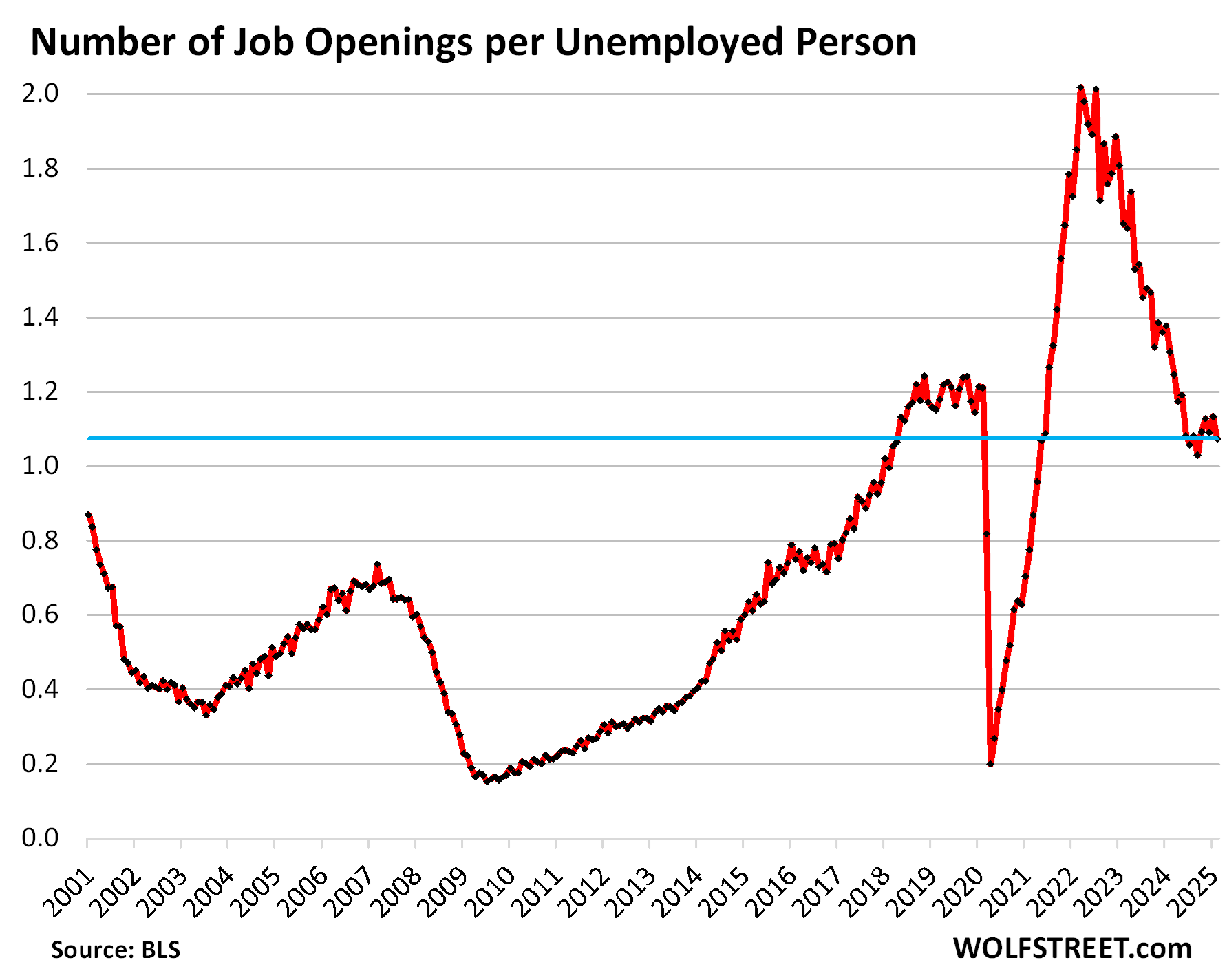
Hires powered by the private sector: Hiring in the private sector rose by 46,000 in February from January to 5.05 million, seasonally adjusted. The low point for private-sector hiring was in June (4.76 million hires).
But government hiring fell by 21,000 to 350,000 hires.
The three-month average private sector hiring rose to 5.02 million. Its low point was in August (4.90 million).
Overall hiring, including government, rose by 25,000 to 5.40 million.
When quits started plunging in 2022, fewer jobs were left behind, job openings plunged, and fewer people needed to be hired to fill left-behind openings, and so hires plunged along with it. But all that has now settled down.

Layoffs and discharges powered by the government: These are workers who got fired with or without cause – a common feature of the US labor market – and workers who got laid off for economic reasons. It does not include retirements, deaths, etc., which are in the category of “other separations.”
Total layoffs and discharges in February rose by 116,000 in February from January, to 1.79 million.
Government layoffs and discharges jumped by 21,000 in February from January, to 99,000, the highest number of layoffs and discharges since the end of the Census-taking period in 2020 that occurs every 10 years.
The three-month average ticked up a hair after two months of big drops.
Despite the surge in government layoffs and discharges, total layoffs and discharges remain at the very low end of the prepandemic labor market.
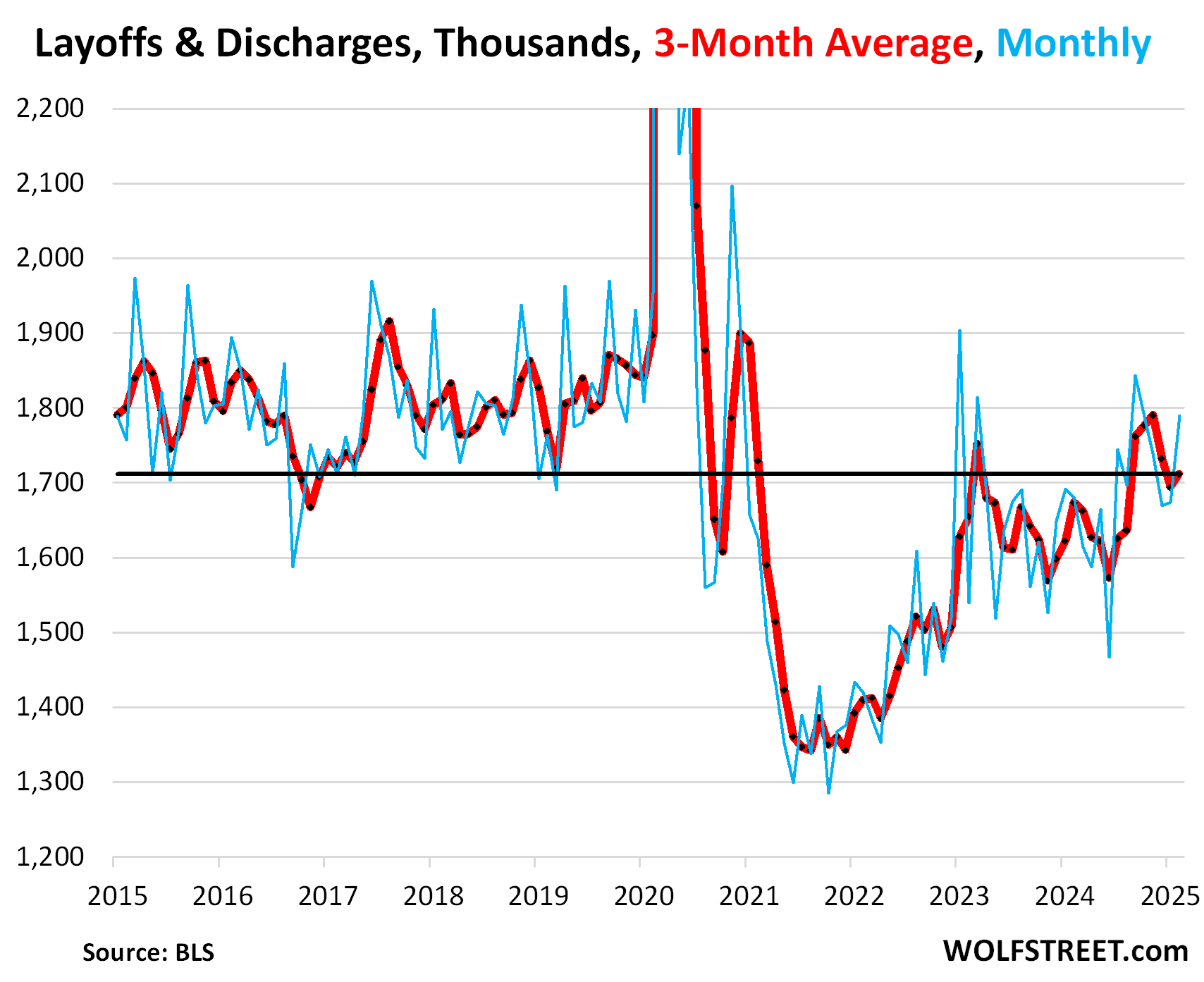
Layoffs and discharges as percent of nonfarm payrolls ticked up to 1.07%, well below any time during the pre-pandemic years in the JOLTS data going back to 2001.
This ratio accounts for growing employment over the years and is the metric that really matters for a long-term view. It shows that layoffs and discharges are historically low compared to the size of nonfarm employment as employers are hanging on to their workers.
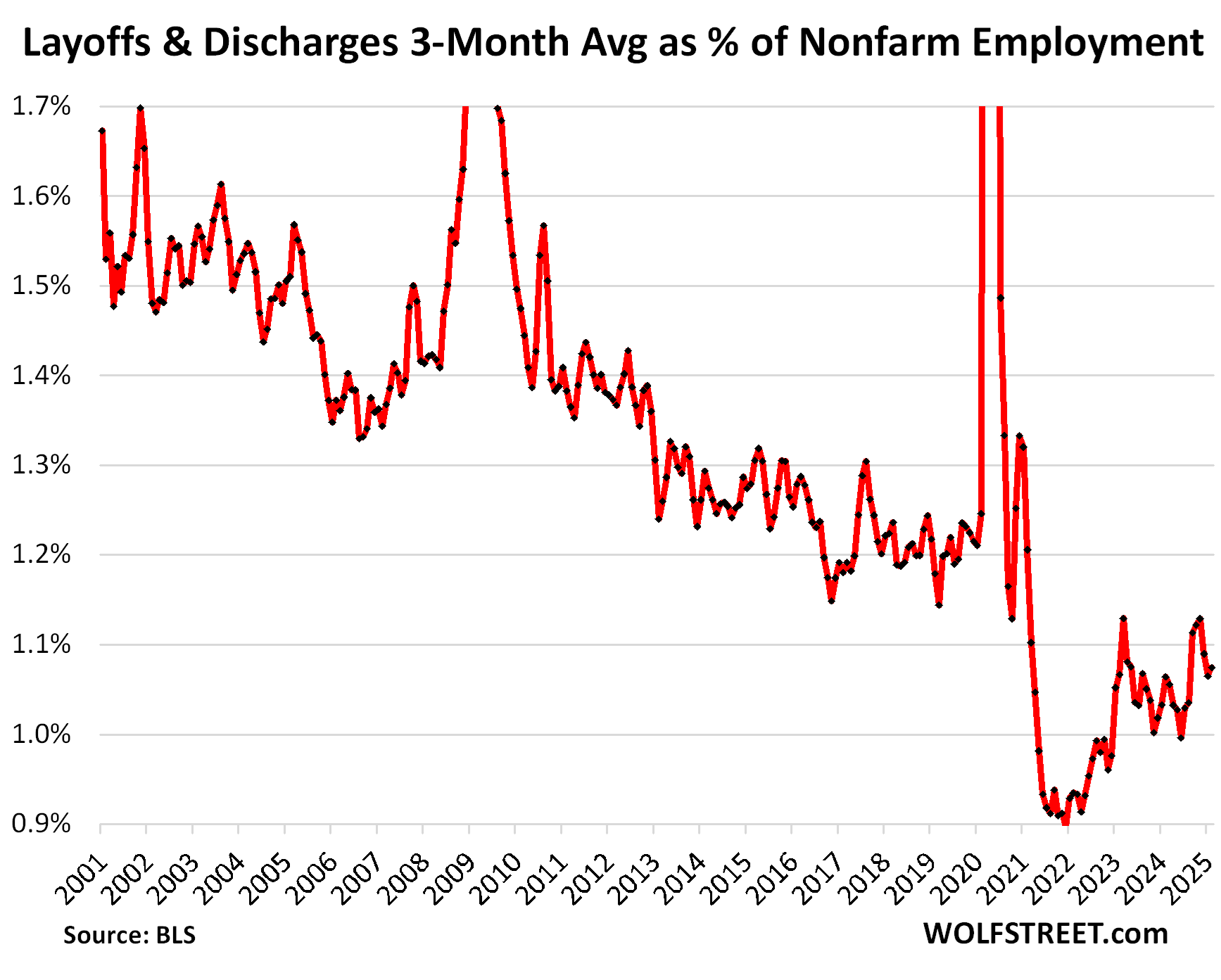
Enjoy reading WOLF STREET and want to support it? You can donate. I appreciate it immensely. Click on the mug to find out how:
![]()


This is what Powell wanted, corporate to reduce the number of job offerings. Imagine those gov employees who were let go had marginal utility and were in clerical or research positions. And about half that same number of people furloughed were deported. There is no way that the labor market gets any slack. And young people are not moving into the trades, saw Mike Rowe on this. Very much like 1970s veterans were piling into apprenticeships and trade union jobs but none of them were working there twenty years later when it was time to retire. Much harder to sell working youth the same old BS, we saw how it works.
Overall, employment seems pretty balanced right now.
The gravy train should continue as long as the government keeps running $2-3T deficits, inflation stays above 2%, and the Fed expands its balance sheet periodically in response to events such as the Great Recession, the pandemic, the repo crisis, the regional banking crisis, a drop in the stock market, or whatever else causes this Fed to push the bright red liquidity button on Jerome’s desk.
All is good and sustainable, right?
There is supply and demand in any “marketplace.”
Supply: We have gone on now for a few years with a tight labor market; by now everyone who could/wants to work would have done so.
Demand: The other side of the tight labor market is demand. This demand has been stated by FOMC chairman Jerome Powell to be responsive to interest rate levels.
Conclusion: With a continuous tight labor market there is no other conclusion than the interest rates are not high enough
The job market is pretty strange out there.
Anecdotally, I have a friend who just started a new job, after applying for, and interviewing for more jobs than the rest of his life combined!
A couple were on him (a job accepted, with an offer that evaporated while he declined a different offer… thinking he had a job).
BUT, he was looking online at other commentaries from people saying that there was no communication from companies about receiving their applications. Companies are slow to decide, and again not communicating, post interview.
Process is prolonged. I think there’s a lot of uncertainty (see stock volatility) and companies have learned from the employee:
Keep your options open, and keep people on the hook. Then feel free to just ghost them or randomly “get back” a matter of weeks later.
Interesting times. My boss has also predicted 4 of the last 0 recessions and is on the trail again (though his and my jobs are fairly recession proof).
So this is going to be a test of the popular “lazy government workers wouldn’t get a job in the private sector” theory?
In my opinion this is a totally false assumption – people with a lifetime of government experience will be in huge demand at government contractors to sell on services to local or federal level. For twice the price as before. A lot of Big Ag companies would be happy to have some former USDA bureaucrats onboard for example. Not to mention consulting. Plenty of know-how on how to dodge regulations.
We shall see, but I doubt these people will have to look for a gig economy job.
Otherwise the gov. layoffs don’t seem to affect the labour market in a major way. That is a very small tick up in layoffs, could be amplified by seasonal effects (post-election months seem to increase fluctuation).
Many of the most qualified will get jobs….but perhaps not in the USA. Researchers/project managers/executives ect. Are in high demand in other markets – Europe/Canada/Asia/Middle East ect…
The huge wave of millions of immigrants over the last several years seems to be keeping labor figures tight? Wolf, is that accurate? Right now deportations are at about the same level as they were under Biden, so I’m not sure the “threats” of “massive deportations” will move the needle much. Your thoughts?
Exports the same. How do we then figure in the drop of imports?
I don’t think we will see massive layoffs from corporations until corporate profits fall as a result of the massive international trade disruption. So, we are probably looking at the profits results for 25Q3 in Oct. & Nov. Falling Profits will be announced at the same time as layoffs (to give the share price a boost). The cost of layoffs will be flagged as “exceptional items” and headline profits will be “excluding exceptional items”.
The Fed can’t really cut interest rates (because of ongoing inflation) until it becomes clear unemployment is going back to 10%.
Last time they cut ….because they were “spooked”.
Very skeptical they will wait to 10% unemployment.
Did the release of this data include anything about retirements? With the baby boomers rolling out of the workforce, I’d expect that to keep the labor market tight. But I have no idea what percentage the baby boomers make up.
As I said in the article, retirements are included in “other separations,” which I don’t cover because the numbers are relatively small. But they had soared in 2021 and early 2022, which is when the big wave of retirements happened. Then they fell. They hit a historic low in Sep 2024 and in February (this report) were barely above that historic low.
The boomer generation was highly influenced by the previous, and is a part of the “when I quit working I die.” Mentality (IMO).
The ones who don’t have that mindset took the pandemic as license to “adios.”
Also: for the trillions of wealth controlled by the generation, it’s distributed in the historical norm: the 10%… and the rest.
“The rest” face the same inflationary pressures as the younger generations, accentuated by healthcare. Working can provide the benefits to offset those costs.
Summary: Boomers feel “too broke to retire”/ fear not working.
It seems as if these Government statistics always overlook a very important points:
1.) For those who’ve been unemployed for over 26 weeks, they no longer receive unemployment benefits. That means they receive *zero* dollars from that point.
2.) The unemployment office will *not allow them to continue to even submit requests for benefits after 26 weeks* yet the Gov’t often says that the number of requests for unemployment benefits “decreased in the month of xxxx” . This is such garbage. The requests decreased because the online job portals for Unemployment benefits *stop working* for workers who’ve received their max benefits. The Gov’t *never ever says this* .
3.) Apparently, workers who’ve been unemployed for over 26 weeks now become “invisible” indefinitely … well, until tax time that is.
4.) The Unemployment numbers published by Gov’t seem to only include those who are actively receiving unemployment benefits – which again, is only some people.
Complete ignorant BS. This data is NOT based on unemployment insurance claims submitted to states, which is what you’re referring to. RTGDFA before posting BS.